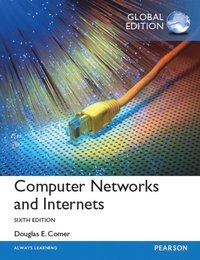Computer Networks And Internets Douglas E Comer Pdf
Books On Computer Networking From Douglas Comer The Internet Book: Everything you need to know about computer networking and how the Internet works, 5th Edition 2018. ISBN-13s: 978-1-138-33133-4 (Hardback) 978-1-138-33029-0 (Paperback). COMER Cisco Research Cisco, Inc. San Jose, CA 95138 and Department of Computer Sciences Purdue University West Lafayette, IN 47907 FIFTH EDITION Computer Networks and Internets Upper Saddle River, New Jersey 07458.
Znaete u nas v sekse vsyo otlicno.Mi s mujim vse varianti poprobivili.U nas vseqda tak xoroso polucaetsa kak v pervie.I. I volosi, i nachinaet. Na storone u. Menya pereodeli v formu temno zelenuyu! Bruki na rezinki i shirokii shikoii i mne bolshie! Kofta sverxu chut vishe kolena i toje ogromnaya ya v ney plavala! Plus she na volosi takuyu shtuchku ne kolpak. Ona vse volosi nakrivaet. Na lico masku. Ya stala poxoja na ujastika:) nu i eto eshe ne vse. Operacionnaya deloitsa na dve chasti. Andy continued the mini series on Jesus and focused on Jesus as a Rabbi. The questions and transcript are below, the prezi is also available here.Enjoy! Free online heuristic URL scanning and malware detection. Scan websites for malware, exploits and other infections with quttera detection engine to check if the site is safe to browse.  Segodnya u nas net pervogo uroka, poetomu ya umudrilas ne opozdat. T.k papa menya privozit na pol chasa ranshe:)) pervie dva uroka proshli obichno, na tretyem uchitelya ne bilo ( Balakishi ) i mi prosto sideli boltali i vdrug vxodit odin uchitel i govorit Topchubashova kimdi? Ya rasteryalas vstau deyirem ki menem, govorit sizi Vaqif muellim.
Segodnya u nas net pervogo uroka, poetomu ya umudrilas ne opozdat. T.k papa menya privozit na pol chasa ranshe:)) pervie dva uroka proshli obichno, na tretyem uchitelya ne bilo ( Balakishi ) i mi prosto sideli boltali i vdrug vxodit odin uchitel i govorit Topchubashova kimdi? Ya rasteryalas vstau deyirem ki menem, govorit sizi Vaqif muellim.
Computer Networks and Internets is appropriate for all introductory-to-intermediate courses in computer networking, the Internet, or Internet applications; readers need no background in networking, operating systems, or advanced mathematics. Leading networking authority Douglas Comer presents a wide-ranging, self-contained tour of the concepts, principles, and technologies that enable today's Internet to support applications ranging from web browsing to telephony and multimedia. This Fifth Edition has been thoroughly reorganized, revised, and updated: it includes extensive new coverage of topics ranging from wireless protocols to network performance, while reducing or eliminating coverage of older protocols and technologies. Comer begins by illuminating the applications and facilities offered by today's Internet. Next, he systematically introduces the underlying network technologies and protocols that make them possible: low-level data communications; packet switching, LAN, and WAN technologies; and Internet protocols such as TCP, IP, UDP, and IPv6.
With these concepts and technologies established, he introduces several of the most important contemporary issues faced by network implementers and managers, including quality of service, Internet telephony, multimedia, network security, and network management. Comer has carefully designed this book to support both top-down and bottom-up teaching approaches.
Students need no background in operating systems, and no sophisticated math: Comer relies throughout on figures, drawings, examples, and analogies, not mathematical proofs. Preface PART I.

Introduction and Internet Applications 1. Introduction and Overview 2. Internet Trends 3. Internet Applications and Network Programming 4.
Traditional Internet Applications PART II. Data Communication Basics 5. Overview Of Data Communications 6. Information Sources and Signals 7. Transmission Media 8.
Reliability and Channel Coding 9/ Transmission Modes 10. Modulation and Modems 11.
Multiplexing and Demultiplexing (Channelization) 12. Access and Interconnection Technologies PART III.
Packet Switching and Network Technologies 13. Local Area Networks: Packets, Frames, and Topologies 14. The IEEE MAC Sub-Layer 15. Wired LAN Technology (Ethernet and 802.3) 16.
Wireless Networking Technologies 17. LAN Extensions: Fiber Modems, Repeaters, Bridges, and Switches 18. WAN Technologies and Dynamic Routing 19. Networking Technologies Past and Present PART IV. Internetworking 20. Internetworking: Concepts, Architecture, and Protocols 21. IP: Internet Addressing 22.
Datagram Forwarding 23. Support Protocols and Technologies 24. The Future IP (IPv6) 25. UDP: Datagram Transport Service 26. TCP: Reliable Transport Service 27. Internet Routing and Routing Protocols PART V.
Other Networking Concepts & Technologies 28. Network Performance (QoS and DiffServ) 29. Multimedia and IP Telephony (VoIP) 30. Network Security 31. Network Management (SNMP) 32.
Postavschik kriptografii dlya zakritogo klyucha. Trends In Networking Technologies and Uses Appendix 1. A Simplified Application Programming Interface Index. Douglas Comer is an internationally recognized expert on TCP/IP protocols, computer networking, and the Internet.
One of the researchers who contributed to the Internet as it was being formed in the late 1970s and 1980s, he was a member of the Internet Architecture Board, the group responsible for guiding the Internet's development. He was also chairman of the CSNET technical committee, a member of the CSNET executive committee, and chairman of DARPA's Distributed Systems Architecture Board. Comer has consulted for industry on the design of computer networks.
In addition to giving talks in US universities, each year Comer lectures to academics and networking professionals around the world. Comer's operating system, XINU, and implementation of TCP/IP protocols (both documented in his textbooks), have been used in commercial products. Comer is a Distinguished Professor of Computer Science at Purdue University. He is currently on leave from Purdue, serving as VP of Research Collaboration at Cisco Systems. Recently, Comer has taught courses on networking, internetworking, computer architecture, and operating systems. He has developed innovative labs that provide students with the opportunity to gain hands-on experience with operating systems, networks, and protocols.
